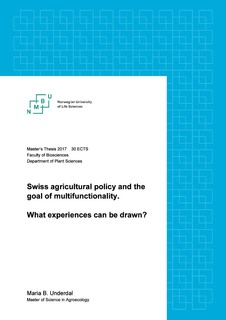| dc.description.abstract | After the Second World War, a productivist focus has led to agricultural policy stimulating intensification of agriculture, creating overproduction and environmental problems. As a reaction, ‘multifunctionality’ became an issue within agricultural policies in Europe, including the EU. However, two non-EU member countries; Norway and Switzerland, have a long tradition for multifunctional agricultural policies, including aims such as rural viability, rural settlement and securing farm income. Later, environmental issues, cultural landscape and biodiversity maintenance became more important. From the 1990s onward multifunctionality emerged as an approach to deal with these environmental challenges and to ensure provision of public goods to society. Norway and Switzerland have stood out as countries with a strong willingness to ensure the multifunctional role of agriculture. However, in Norway the efficiency and effectiveness of policy systems to meet multifunctional goals are in question, and in the Norwegian debate Switzerland has been referred to as performing better.
The aim of this study has been to learn more about the Swiss goal achievement in terms of multifunctionality, and what factors and drivers that have led up to this. The main aspects addressed are; cultural landscape, use of grassland resources, rural settlement, and farm income. The study is based on qualitative methods with literature and document analysis, and semi-structured interviews with key Swiss informants to get their assessment of the situation.
The results may indicate that Switzerland is performing better than Norway on certain issues, although advances are needed in terms of improving goal achievement. In Switzerland, the Swiss population has had a significant role, through their support for agriculture, and their vote in 1996, adding multifunctional agriculture as a goal in Article 104 of the constitution. Article 104 gave the Swiss Federal Office of Agriculture a direction, and they were thus able to push for agricultural reforms. These reforms have gone towards less market support, and more direct payments for public goods. Market orientation has both been a goal and a tool to reduce production stimulating policies. A strong farmers lobby grew up after the Second World War, and has been important in ensuring support for agriculture, while environmental oriented groups have pushed for an agriculture that ensures the provision of public goods. The policy system has become increasingly targeted towards the multifunctional goals in the Article 104. Still, there is a conflict between environmental goals and increased production. A targeted system in which each goal described in Article 104 has a specific payment was seen as a solution for Switzerland.
Norway can draw on the Swiss experiences, especially in terms of the directionality that the system has had since the 1990s, due to strong legitimacy of the goals in Article 104 of the constitution. The Swiss case also shows an alternative to how one can support agriculture, which hopefully could spur further debate in Norway. | nb_NO |

